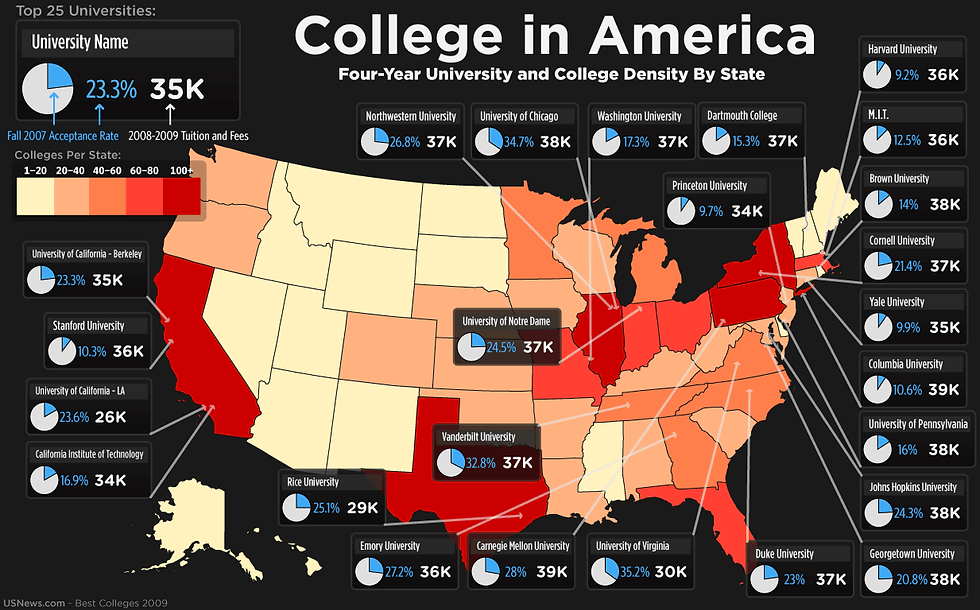Education in the USA
- Genius Nets
- 25 авг. 2015 г.
- 4 мин. чтения
The US remains the world's leading destination for international students. In 2011-12, around 764,500 international students chose to study in the US, according to the Institute of International Education's Open Doors report. The most popular states for international study in the US were California, New York and Texas, and the most popular subjects were business and management, engineering, mathematics and computer science.
Of course, it’s not just the high standard of US universities that draws students in. Whether you’re attracted to the bright lights and fast pace of the big city or to miles and miles of unspoiled wilderness; sun-kissed beaches or lush forests; the rustic and traditional or the sleek and modern, this huge and incredibly diverse country has something for everyone.

The sheer volume and variety of universities in the US means that you can be pretty confident of finding a suitable institution in your preferred surroundings. And if you don’t get it right the first time, moving between universities in the US is not uncommon.
Undergraduate degrees at US universities typically take four years to complete. The first part of the degree is usually spent studying a wide range of subjects – some required and some electives – after which students choose the subject or subjects on which they want to focus – known as “major(s)”.
You may also earn a “minor” qualification alongside your major by completing classes in an additional field. This is often used to supplement the major degree. For example, business majors often minor in economics, while liberal arts majors may minor in philosophy. Some students also choose minors simply to explore a subject of interest to them without having to commit to a full study of the subject, and regardless of whether it pertains to the field in which they seek employment.

In terms of fees, US universities do not tend to differentiate between domestic and international students. Public universities charge lower fees for students from within the same state compared to everyone else, while private universities usually have one set fee for everyone.
However, fees do vary significantly from university to university. Studying in the US certainly won’t be cheap, but most US universities are very good at providing accessible information about the expected cost of study – including tuition fees, course resources, accommodation, food, insurance and other expenses.
There’s also a good chance you will not have to pay the full tuition fee amount. At many universities in the US, a majority of students receive financial aid, via various grants, scholarships, loan and work-study schemes.
US financial aid is usually supplied based on two distinct criteria: merit-based and need-based. Need-based aid is based on an assessment of the student’s financial circumstances, while merit-based aid considers their academic grades, athletic performance, involvement in organizations and other outstanding talents.
While international students are not eligible for federal aid provided by the US government, many universities in the US provide their own aid schemes – both need- and merit-based. Six US universities also offer fully need-blind admissions to domestic and international students: Amherst, Yale, Dartmouth, Princeton, MIT and Harvard. This means students are accepted without any consideration of their ability to pay, and the university then pledges to contribute as much as is necessary to enable them to attend.
If you want to get an idea of what US financial aid you’re eligible for, use the ‘net price calculator’ on university websites (all institutions are required to offer this service).
To start your application to study in the US, you will need to apply directly to each of the universities you’re interested in. Remember that athletic recruitment process and sports scholarships follow a slightly different timeline to regular applications, so it’s worthwhile checking the application deadlines early (1-1 ½ years before enrolment) to avoid missing out.
Entry requirements for each university are different, but most involve either completing an admissions test or essay, the SAT or ACT admissions tests, and providing recommendation letters from teachers. On top of this, most universities ask for a transcript of your grades and a personal statement.

If you are accepted you’ll be entered into an international student database called the Student and Exchange Visitor Information System (SEVIS), and sent a copy of the information stored on this, which you will need to check for accuracy.
It’s also important to ensure that you pay the application fee (the SEVIS I-901 fee) for this database service, which will be US$200. A few universities also allow international students to apply for free online. The university will then provide you with a Form I-20 to present to the US embassy when you attend your visa interview.
You will then be ready to apply for your F-1 non-immigrant visa. In order to obtain this you will need to arrange an interview at your local US embassy, following the US visa requirements process below:
Pay the MRV visa application fee of US$160 (the embassy will tell you where you should pay this).
Complete a DS-160 form online, uploading a photograph.
Bring to the interview your acceptance letter, proof you’ve paid all the fees and filled in the right forms, the Form I-20 or Form DS-2019, which is a Certificate of Eligibility, and a passport which doesn’t expire until six months after you complete your degree.
Link: http://www.topuniversities.com/where-to-study/north-america/united-states/

Комментарии